ESP MITSUBISHI GRANDIS 2008 (in English) User Guide
[x] Cancel search | Manufacturer: MITSUBISHI, Model Year: 2008, Model line: GRANDIS, Model: MITSUBISHI GRANDIS 2008Pages: 458, PDF Size: 18.52 MB
Page 106 of 458
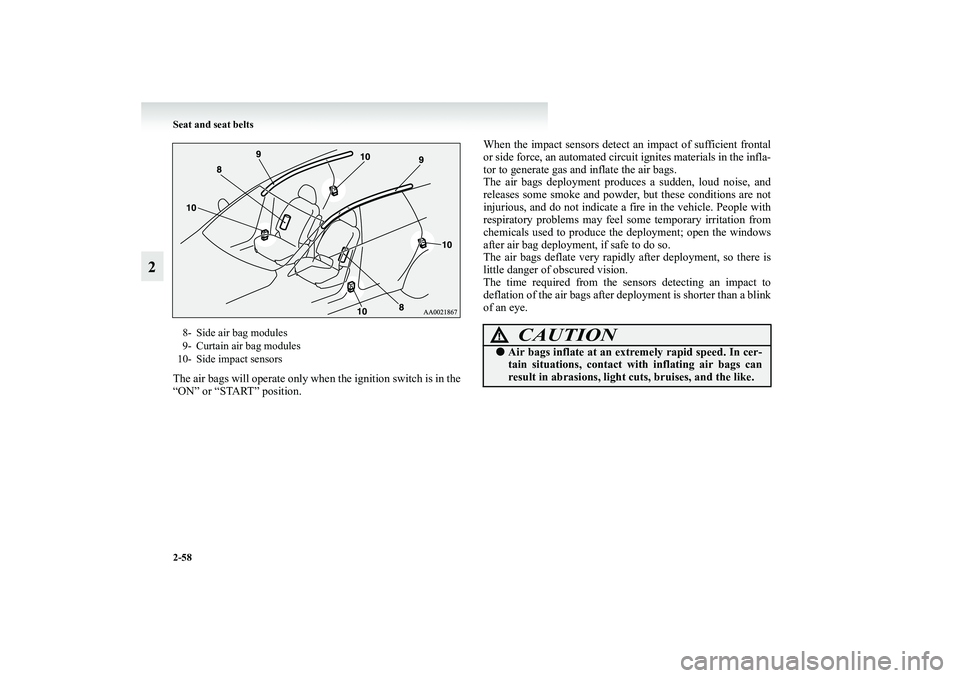
2-58 Seat and seat belts
2
The air bags will operate only when the ignition switch is in the
“ON” or “START” position.When the impact sensors detect an impact of sufficient frontal
or side force, an automated circuit ignites materials in the infla-
tor to generate gas and inflate the air bags.
The air bags deployment produces a sudden, loud noise, and
releases some smoke and powder, but these conditions are not
injurious, and do not indicate a fire in the vehicle. People with
respiratory problems may feel some temporary irritation from
chemicals used to produce the deployment; open the windows
after air bag deployment, if safe to do so.
The air bags deflate very rapidly after deployment, so there is
little danger of obscured vision.
The time required from the sensors detecting an impact to
deflation of the air bags after deployment is shorter than a blink
of an eye.8- Side air bag modules
9- Curtain air bag modules
10- Side impact sensors
CAUTION
!●Air bags inflate at an extremely rapid speed. In cer-
tain situations, contact with inflating air bags can
result in abrasions, light cuts, bruises, and the like.
BK-XP08E1ENUK.en-uk.book Page 58 Monday, August 13, 2007 2:20 PM
Page 113 of 458
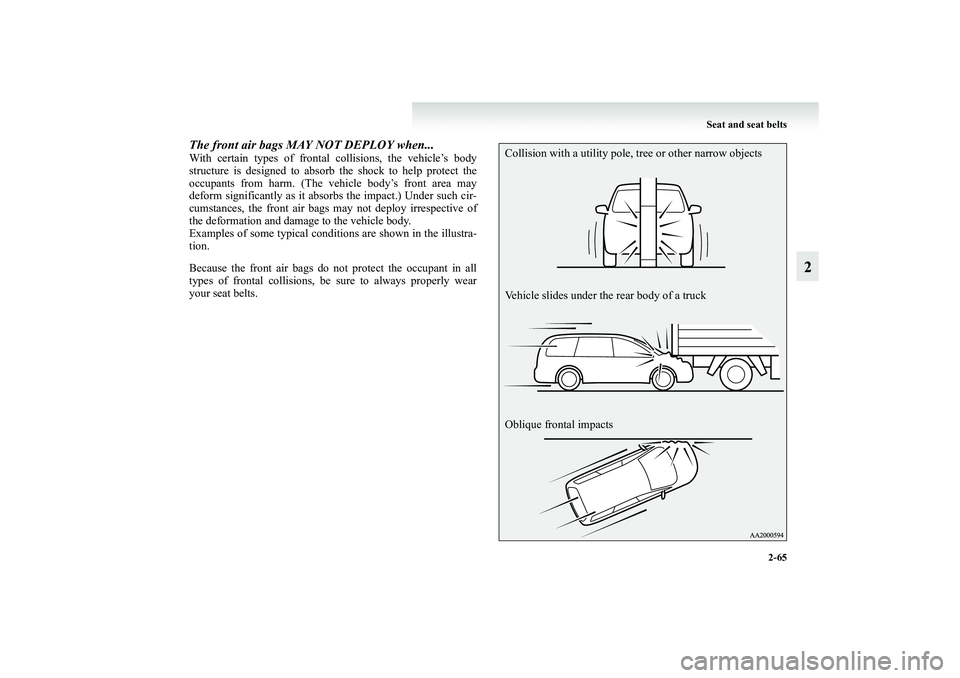
Seat and seat belts
2-65
2
The front air bags MAY NOT DEPLOY when... With certain types of frontal collisions, the vehicle’s body
structure is designed to absorb the shock to help protect the
occupants from harm. (The vehicle body’s front area may
deform significantly as it absorbs the impact.) Under such cir-
cumstances, the front air bags may not deploy irrespective of
the deformation and damage to the vehicle body.
Examples of some typical conditions are shown in the illustra-
tion.
Because the front air bags do not protect the occupant in all
types of frontal collisions, be sure to always properly wear
your seat belts.
Collision with a utility pole, tree or other narrow objects
Vehicle slides under the rear body of a truck
Oblique frontal impacts
BK-XP08E1ENUK.en-uk.book Page 65 Monday, August 13, 2007 2:20 PM
Page 119 of 458
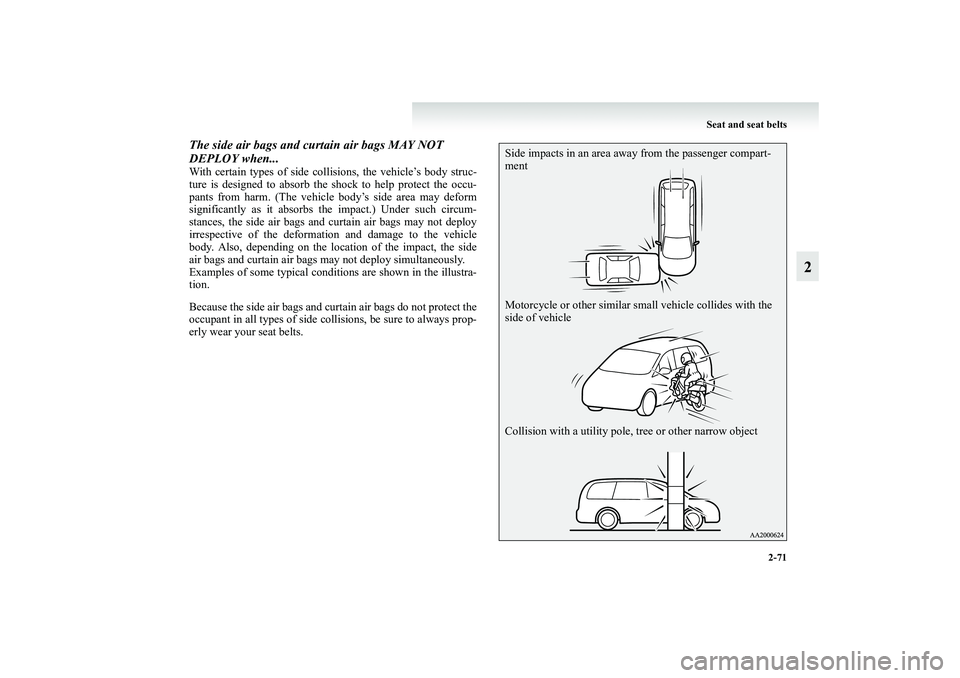
Seat and seat belts
2-71
2
The side air bags and curtain air bags MAY NOT
DEPLOY when...With certain types of side collisions, the vehicle’s body struc-
ture is designed to absorb the shock to help protect the occu-
pants from harm. (The vehicle body’s side area may deform
significantly as it absorbs the impact.) Under such circum-
stances, the side air bags and curtain air bags may not deploy
irrespective of the deformation and damage to the vehicle
body. Also, depending on the location of the impact, the side
air bags and curtain air bags may not deploy simultaneously.
Examples of some typical conditions are shown in the illustra-
tion.
Because the side air bags and curtain air bags do not protect the
occupant in all types of side collisions, be sure to always prop-
erly wear your seat belts.
Side impacts in an area away from the passenger compart-
ment
Motorcycle or other similar small vehicle collides with the
side of vehicle
Collision with a utility pole, tree or other narrow object
BK-XP08E1ENUK.en-uk.book Page 71 Monday, August 13, 2007 2:20 PM
Page 138 of 458

3-12 Instruments and controls
3
NOTE●The engine electronic control module
accommodating the onboard diagnostic sys-
tem has various fault data (especially about
the exhaust emission) stored.
This data will be erased if a battery cable is
disconnected which will make a rapid diag-
nosis difficult. Do not disconnect a battery
cable when the check engine warning lamp
is ON.
Check engine warning lamp (diesel-
powered vehicles)
E00502600628
This lamp is a part of an onboard diagnostic sys-
tem which monitors the emissions control sys-
tems.
If a problem is detected in one of these systems,
this lamp illuminates.
Although your vehicle will usually be drivable
and not need towing, we recommend you to have
the system checked as soon as possible.
This lamp will also illuminate for a few seconds
when the ignition key is turned to the “ON” posi-
tion. If it does not go off after a few seconds, we
recommend you to have the vehicle checked.
●If the lamp illuminates or flashes while
the engine is running, avoid driving at
high speeds and we recommend you to
have the system checked.
During vehicle operation with the
lamp illuminated or flashing, the vehi-
cle may not accelerate when you
depress the accelerator pedal.
When the vehicle is stationary with the
lamp illuminated or flashing, you must
depress the brake pedal more firmly
than usual since the engine idling
speed is higher than usual and the
vehicle with an A/T has a stronger ten-
dency to creep forward.
CAUTION
!
CAUTION
!●Prolonged driving with this lamp on
may cause further damage to the emis-
sion control system. It could also affect
fuel economy and drivability.●If the lamp does not illuminate when
the ignition key is turned to the “ON”
position, we recommend you to have
the system checked.
BK-XP08E1ENUK.en-uk.book Page 12 Monday, August 13, 2007 2:20 PM
Page 139 of 458

Instruments and controls
3-13
3
NOTE●The engine electronic control module
accommodating the onboard diagnostic sys-
tem has various fault data (especially about
the exhaust emission) stored.
This data will be erased if a battery cable is
disconnected which will make a rapid diag-
nosis difficult. Do not disconnect a battery
cable when the check engine warning lamp
is ON.
Charge warning lamp
E00502700300
This lamp illuminates when the ignition key is
turned “ON”, and the lamp goes off after the
engine has started.
●If the lamp illuminates while the
engine is running, avoid driving at
high speeds and we recommend you to
have the system checked.
During vehicle operation with the
lamp illuminated, the vehicle may not
accelerate when you depress the accel-
erator pedal.
When the vehicle is stationary with the
lamp illuminated, you must depress
the brake pedal more firmly than usual
since the engine idling speed is higher
than usual.
CAUTION
!
CAUTION
!●If it illuminates while the engine is run-
ning, there is a problem in the charg-
ing system. In this case, immediately
park your vehicle in a safe place and
we recommend you to have it checked.
BK-XP08E1ENUK.en-uk.book Page 13 Monday, August 13, 2007 2:20 PM
Page 174 of 458

4-2 Starting and driving
4Economical driving
E00600100372
For economical driving, there are some technical requirements
that have to be met. The prerequisite for low fuel consumption
is a properly adjusted engine. In order to achieve longer life of
the vehicle and the most economical operation, we recommend
you have the vehicle checked at regular intervals in accordance
with the service standards.
Fuel economy and generation of exhaust gas and noise are
highly influenced by personal driving habits as well as the par-
ticular operating conditions. The following points should be
observed in order to minimize wear of brakes, tyres and engine
as well as to reduce environmental pollution.StartingAvoid rapid acceleration and sudden starts; such operation will
result in higher fuel consumption.ShiftingShift only at an appropriate speed and engine speed. Always
use the highest gear possible.City trafficFrequent starting and stopping increases the average fuel con-
sumption. Use roads with smooth traffic flow whenever possi-
ble. When driving on congested roads, avoid use of a low gear
at high engine speeds.IdlingThe vehicle consumes fuel even during idling. Avoid extended
idling whenever possible.
SpeedThe higher the vehicle speed, the more fuel consumed. Avoid
driving at full speed. Even a slight release of the accelerator
pedal will save a significant amount of fuel.Tyre inflation pressureCheck the tyre inflation pressures at regular intervals. Low tyre
inflation pressure increases road resistance and fuel consump-
tion. In addition, low tyre pressures adversely affect tyre wear
and driving stability.LoadDo not drive with unnecessary articles in the luggage compart-
ment. Especially during city driving where frequent starting
and stopping is necessary, the increased weight of the vehicle
will greatly affect fuel consumption. Also avoid driving with
unnecessary luggage, etc., on the roof; the increased air resist-
ance will increase fuel consumption.Cold engine startingStarting of a cold engine consumes more fuel.
Unnecessary fuel consumption is also caused by keeping a hot
engine running. After the engine is started, commence driving
as soon as possible.Air conditioningThe use of the air conditioning will increase the fuel consump-
tion.
BK-XP08E1ENUK.en-uk.book Page 2 Monday, August 13, 2007 2:20 PM
Page 190 of 458
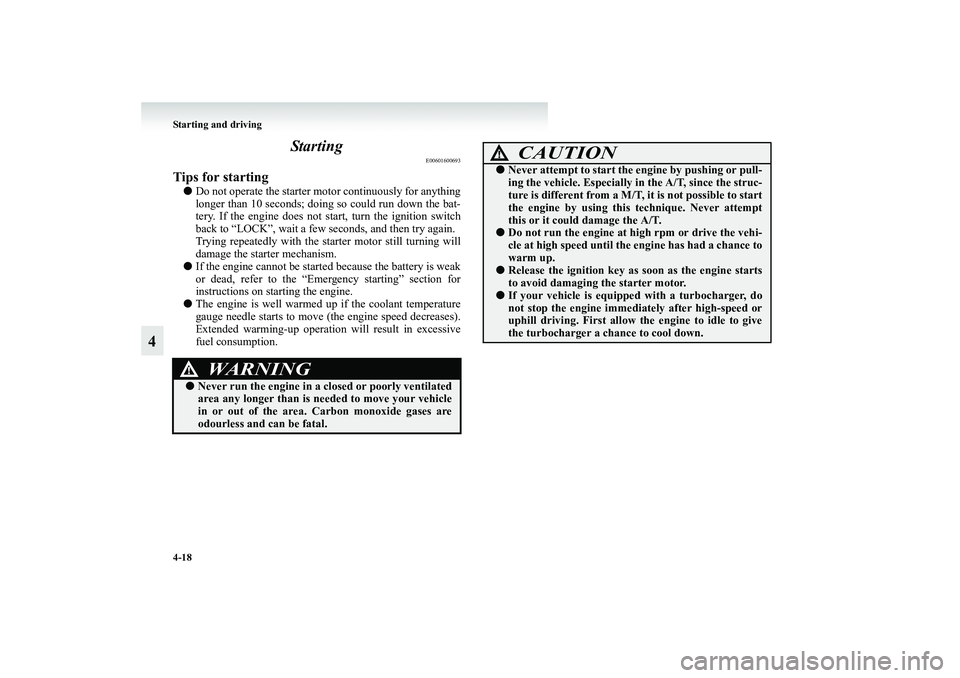
4-18 Starting and driving
4Starting
E00601600693
Tips for starting●Do not operate the starter motor continuously for anything
longer than 10 seconds; doing so could run down the bat-
tery. If the engine does not start, turn the ignition switch
back to “LOCK”, wait a few seconds, and then try again.
Trying repeatedly with the starter motor still turning will
damage the starter mechanism.
●If the engine cannot be started because the battery is weak
or dead, refer to the “Emergency starting” section for
instructions on starting the engine.
●The engine is well warmed up if the coolant temperature
gauge needle starts to move (the engine speed decreases).
Extended warming-up operation will result in excessive
fuel consumption.
WARNING
!●Never run the engine in a closed or poorly ventilated
area any longer than is needed to move your vehicle
in or out of the area. Carbon monoxide gases are
odourless and can be fatal.
CAUTION
!●Never attempt to start the engine by pushing or pull-
ing the vehicle. Especially in the A/T, since the struc-
ture is different from a M/T, it is not possible to start
the engine by using this technique. Never attempt
this or it could damage the A/T.●Do not run the engine at high rpm or drive the vehi-
cle at high speed until the engine has had a chance to
warm up.●Release the ignition key as soon as the engine starts
to avoid damaging the starter motor.●If your vehicle is equipped with a turbocharger, do
not stop the engine immediately after high-speed or
uphill driving. First allow the engine to idle to give
the turbocharger a chance to cool down.
BK-XP08E1ENUK.en-uk.book Page 18 Monday, August 13, 2007 2:20 PM
Page 197 of 458

Starting and driving
4-25
4
Economical driving speed
E00610700443
The following shift points are recommended to assist fuel
economy. The driver may vary these points to suit driving con-
ditions and load.
5 M/T
6 M/T
Possible driving speed
E00610800431
5 M/T
5th gear is an overdrive ratio and its use reduces engine speed
below that of the 4th gear. Use 5th gear whenever vehicle
speed allows, for maximum fuel economy.
6 M/T
The 4th, 5th and 6th gears have overdrive ratios and their use
reduces the engine speeds below those of the 3rd, 4th and 5th
gear, respectively. Use the 4th, 5th or 6th gear whenever the
vehicle speed allows, for maximum fuel economy.
Shift point
Speed limit
1st gear to 2nd gear 30 km/h (19 mph)2nd gear to 3rd gear 55 km/h (34 mph)3rd gear to 4th gear 85 km/h (53 mph)4th gear to 5th gear 115 km/h (71 mph)
Shift point
Speed limit
1st gear to 2nd gear 10 km/h (6 mph)2nd gear to 3rd gear 25 km/h (16 mph)3rd gear to 4th gear 35 km/h (22 mph)4th gear to 5th gear 50 km/h (31 mph)5th gear to 6th gear 65 km/h (40 mph)
Shift point
Speed limit
1st gear 50 km/h (31 mph)2nd gear 90 km/h (56 mph)3rd gear 140 km/h (87 mph)4th gear 185 km/h (115 mph)Shift point
Speed limit
1st gear 35 km/h (22 mph)2nd gear 65 km/h (40 mph)3rd gear 95 km/h (59 mph)4th gear 135 km/h (84 mph)5th gear 170 km/h (106 mph)
BK-XP08E1ENUK.en-uk.book Page 25 Monday, August 13, 2007 2:20 PM
Page 204 of 458

4-32 Starting and driving
4
Sports mode indicator lamp
E00612300010
In sports mode, the currently selected position is indicated on
the instrument panel.NOTE●When sports mode is selected, the “D” indicator lamp
goes off.
Operation of the A/T
E00604200065
CAUTION
!●Before selecting a gear with the engine running and
the vehicle stationary, fully depress the brake pedal
to prevent the vehicle from creeping.
The vehicle will begin to move as soon as the gear is
engaged, especially when the engine speed is high, at
fast idle or with the air conditioning operating, the
brakes should only be released when you are ready
to drive away.●Depress the brake pedal with the right foot at all
times.
Using the left foot could cause driver movement
delay in case of an emergency.●To prevent sudden acceleration, never race the
engine when shifting from the “P” (PARK) or
“N” (NEUTRAL) position.●Operating the accelerator pedal while the other foot
is resting on the brake pedal will affect braking effi-
ciency and may cause premature wear of brake
pads.
Do not race the engine with brake pedal pressed.
This can damage the transmission.
Also, when the vehicle is stationary, the engine revo-
lutions may not rise to the same revolutions as meas-
ured in normal starting even if the accelerator pedal
is depressed while the brake pedal is being pressed.
BK-XP08E1ENUK.en-uk.book Page 32 Monday, August 13, 2007 2:20 PM
Page 207 of 458
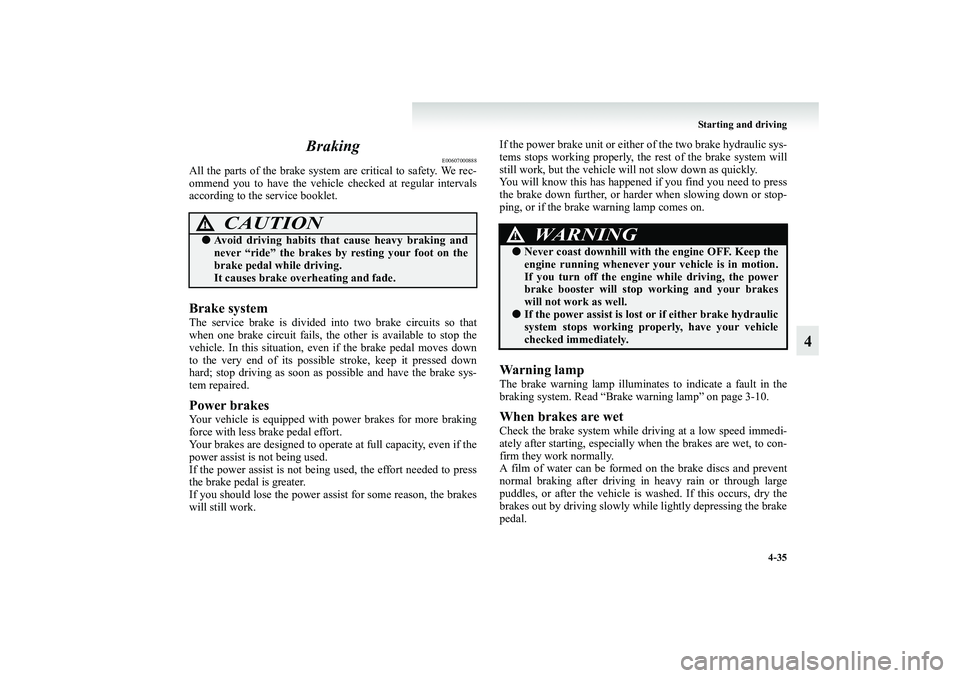
Starting and driving
4-35
4 Braking
E00607000888
All the parts of the brake system are critical to safety. We rec-
ommend you to have the vehicle checked at regular intervals
according to the service booklet.Brake systemThe service brake is divided into two brake circuits so that
when one brake circuit fails, the other is available to stop the
vehicle. In this situation, even if the brake pedal moves down
to the very end of its possible stroke, keep it pressed down
hard; stop driving as soon as possible and have the brake sys-
tem repaired.Power brakesYour vehicle is equipped with power brakes for more braking
force with less brake pedal effort.
Your brakes are designed to operate at full capacity, even if the
power assist is not being used.
If the power assist is not being used, the effort needed to press
the brake pedal is greater.
If you should lose the power assist for some reason, the brakes
will still work.If the power brake unit or either of the two brake hydraulic sys-
tems stops working properly, the rest of the brake system will
still work, but the vehicle will not slow down as quickly.
You will know this has happened if you find you need to press
the brake down further, or harder when slowing down or stop-
ping, or if the brake warning lamp comes on.
Wa r n i n g l a m pThe brake warning lamp illuminates to indicate a fault in the
braking system. Read “Brake warning lamp” on page 3-10.When brakes are wetCheck the brake system while driving at a low speed immedi-
ately after starting, especially when the brakes are wet, to con-
firm they work normally.
A film of water can be formed on the brake discs and prevent
normal braking after driving in heavy rain or through large
puddles, or after the vehicle is washed. If this occurs, dry the
brakes out by driving slowly while lightly depressing the brake
pedal.
CAUTION
!●Avoid driving habits that cause heavy braking and
never “ride” the brakes by resting your foot on the
brake pedal while driving.
It causes brake overheating and fade.
WARNING
!●Never coast downhill with the engine OFF. Keep the
engine running whenever your vehicle is in motion.
If you turn off the engine while driving, the power
brake booster will stop working and your brakes
will not work as well.●If the power assist is lost or if either brake hydraulic
system stops working properly, have your vehicle
checked immediately.
BK-XP08E1ENUK.en-uk.book Page 35 Monday, August 13, 2007 2:20 PM